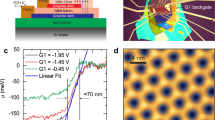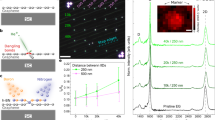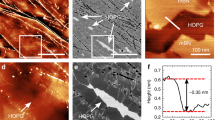Abstract
Defects play a key role in determining the properties and technological applications of nanoscale materials and, because they tend to be highly localized, characterizing them at the single-defect level is of particular importance. Scanning tunnelling microscopy has long been used to image the electronic structure of individual point defects in conductors1, semiconductors2,3,4 and ultrathin films5,6,7,8,9, but such single-defect electronic characterization remains an elusive goal for intrinsic bulk insulators. Here, we show that individual native defects in an intrinsic bulk hexagonal boron nitride insulator can be characterized and manipulated using a scanning tunnelling microscope. This would typically be impossible due to the lack of a conducting drain path for electrical current. We overcome this problem by using a graphene/boron nitride heterostructure, which exploits the atomically thin nature of graphene to allow the visualization of defect phenomena in the underlying bulk boron nitride. We observe three different defect structures that we attribute to defects within the bulk insulating boron nitride. Using scanning tunnelling spectroscopy we obtain charge and energy-level information for these boron nitride defect structures. We also show that it is possible to manipulate the defects through voltage pulses applied to the scanning tunnelling microscope tip.
This is a preview of subscription content, access via your institution
Access options
Subscribe to this journal
Receive 12 print issues and online access
$259.00 per year
only $21.58 per issue
Buy this article
- Purchase on Springer Link
- Instant access to full article PDF
Prices may be subject to local taxes which are calculated during checkout




Similar content being viewed by others
References
Madhavan, V., Chen, W., Jamneala, T., Crommie, M. F. & Wingreen, N. S. Tunneling into a single magnetic atom: spectroscopic evidence of the Kondo resonance. Science 280, 567–569 (1998).
Feenstra, R. M., Woodall, J. M. & Pettit, G. D. Observation of bulk defects by scanning tunneling microscopy and spectroscopy: arsenic antisite defects in GaAs. Phys. Rev. Lett. 71, 1176–1179 (1993).
Teichmann, K. et al. Controlled charge switching on a single donor with a scanning tunneling microscope. Phys. Rev. Lett. 101, 076103 (2008).
Lee, D. H. & Gupta, J. A. Tunable field control over the binding energy of single dopants by a charged vacancy in GaAs. Science 330, 1807–1810 (2010).
Repp, J., Meyer, G., Olsson, F. E. & Persson, M. Controlling the charge state of individual gold adatoms. Science 305, 493–495 (2004).
Pradhan, N. A., Liu, N. & Ho, W. Vibronic spectroscopy of single C60 molecules and monolayers with the STM. J. Phys. Chem. B 109, 8513–8518 (2005).
Avouris, P. & Wolkow, R. Scanning tunneling microscopy of insulators: CaF2 epitaxy on Si(111). Appl. Phys. Lett. 55, 1074–1076 (1989).
Repp, J., Meyer, G., Paavilainen, S., Olsson, F. E. & Persson, M. Scanning tunneling spectroscopy of Cl vacancies in NaCl films: strong electron–phonon coupling in double-barrier tunneling junctions. Phys. Rev. Lett. 95, 225503 (2005).
Choi, T., Ruggiero, C. D. & Gupta, J. A. Incommensurability and atomic structure of c(2×2)N/Cu(100): a scanning tunneling microscopy study. Phys. Rev. B 78, 035430 (2008).
Dean, C. R. et al. Boron nitride substrates for high-quality graphene electronics. Nature Nanotech. 5, 722–726 (2010).
Britnell, L. et al. Strong light–matter interactions in heterostructures of atomically thin films. Science 340, 1311–1314 (2013).
Watanabe, K., Taniguchi, T. & Kanda, H. Direct-bandgap properties and evidence for ultraviolet lasing of hexagonal boron nitride single crystal. Nature Mater. 3, 404–409 (2004).
Taniguchi, T. & Watanabe, K. Synthesis of high-purity boron nitride single crystals under high pressure by using Ba–BN solvent. J. Cryst. Growth 303, 525–529 (2007).
Remes, Z., Nesladek, M., Haenen, K., Watanabe, K. & Taniguchi, T. The optical absorption and photoconductivity spectra of hexagonal boron nitride single crystals. Phys. Status Solidi A 202, 2229–2233 (2005).
Ju, L. et al. Photoinduced doping in heterostructures of graphene and boron nitride. Nature Nanotech. 9, 348–352 (2014).
Xue, J. et al. Scanning tunnelling microscopy and spectroscopy of ultra-flat graphene on hexagonal boron nitride. Nature Mater. 10, 282–285 (2011).
Decker, R. G. et al. Local electronic properties of graphene on a BN substrate via scanning tunneling microscopy. Nano Lett. 11, 2291–2295 (2011).
Zhang, Y. et al. Giant phonon-induced conductance in scanning tunneling spectroscopy of gate-tunable graphene. Nature Phys. 4, 627–630 (2008).
Wang, Y. et al. Mapping Dirac quasiparticles near a single Coulomb impurity on graphene. Nature Phys. 8, 653–657 (2012).
Wang, Y. et al. Observing atomic collapse resonances in artificial nuclei on graphene. Science 340, 734–737 (2013).
Brar, V. W. et al. Gate-controlled ionization and screening of cobalt adatoms on a graphene surface. Nature Phys. 7, 43–47 (2011).
Scheffler, M. et al. Probing local hydrogen impurities in quasi-free-standing graphene. ACS Nano 6, 10590–10597 (2012).
Fanciulli, M. & Moustakas, T. D. Study of defects in wide band gap semiconductors by electron paramagnetic resonance. Physica B 185, 228–233 (1993).
Katzir, A., Suss, J. T., Zunger, A. & Halperin, A. Point defects in hexagonal boron nitride. I. EPR, thermoluminescence, and thermally-stimulated-current measurements. Phys. Rev. B 11, 2370–2377 (1975).
Andrei, E. Y., Katzir, A. & Suss, J. T. Point defects in hexagonal boron nitride. III. EPR in electron-irradiated BN. Phys. Rev. B 13, 2831–2834 (1976).
Zunger, A. & Katzir, A. Point defects in hexagonal boron nitride. II. Theoretical studies. Phys. Rev. B 11, 2378–2390 (1975).
Attaccalite, C., Bockstedte, M., Marini, A., Rubio, A. & Wirtz, L. Coupling of excitons and defect states in boron-nitride nanostructures. Phys. Rev. B 83, 144115 (2011).
Das Sarma, S., Adam, S., Hwang, E. H. & Rossi, E. Electronic transport in two-dimensional graphene. Rev. Mod. Phys. 83, 407–470 (2011).
Woodside, M. T. & McEuen, P. L. Scanned probe imaging of single-electron charge states in nanotube quantum dots. Science 296, 1098–1101 (2002).
Pradhan, N. A., Liu, N., Silien, C. & Ho, W. Atomic scale conductance induced by single impurity charging. Phys. Rev. Lett. 94, 076801 (2005).
Kharche, N. & Nayak, S. K. Quasiparticle band gap engineering of graphene and graphone on hexagonal boron nitride substrate. Nano Lett. 11, 5274–5278 (2011).
Garleff, J. K., Wijnheijmer, A. P., v. d. Enden, C. N. & Koenraad, P. M. Bistable behavior of silicon atoms in the (110) surface of gallium arsenide. Phys. Rev. B 84, 075459 (2011).
Zomer, P. J., Dash, S. P., Tombros, N. & van Wees, B. J. A transfer technique for high mobility graphene devices on commercially available hexagonal boron nitride. Appl. Phys. Lett. 99, 232104–232107 (2011).
Acknowledgements
The authors thank P. Jarillo-Herrero, N. Gabor, A. Young, P. Yu and A. Rubio for discussions. This research was supported by the sp2 programme (STM measurement and device fabrication) and the LBNL Molecular Foundry (graphene growth characterization) funded by the Director, Office of Science, Office of Basic Energy Sciences of the US Department of Energy (contract no. DE-AC02-05CH11231). Support was also provided by National Science Foundation award CMMI-1235361 (device characterization, image analysis). J.V.J. acknowledges support from the UC President's Postdoctoral Fellowship. D.W. was supported by the Department of Defense (DoD) through the National Defense Science & Engineering Graduate Fellowship (NDSEG) Program. S.K. acknowledges support from the Qualcomm Scholars Research Fellowship.
Author information
Authors and Affiliations
Contributions
L.J. and J.V.J. conceived the work and designed the research strategy. J.V.J., D.W., S.K. and J.L. performed data analysis. J.V.J., S.K., L.J. and A.Z. facilitated sample fabrication. D.W., J.L. and J.V.J. carried out STM/ scanning tunnelling spectroscopy (STS) measurements. J.V.J. and S.K. carried out electron transport measurements. K.W. and T.T. synthesized the hBN samples. D.W., J.V.J. and L.J. formulated the theoretical model with advice from F.W. and M.F.C. M.F.C. supervised the STM/STS experiments. J.V.J., D.W. and M.F.C. co-wrote the manuscript. J.V.J. and M.F.C. coordinated the collaboration. All authors discussed the results and commented on the paper.
Corresponding author
Ethics declarations
Competing interests
The authors declare no competing financial interests.
Supplementary information
Supplementary information
Supplementary information (PDF 4623 kb)
Supplementary Movie
Supplementary Movie (MP4 12264 kb)
Rights and permissions
About this article
Cite this article
Wong, D., Velasco, J., Ju, L. et al. Characterization and manipulation of individual defects in insulating hexagonal boron nitride using scanning tunnelling microscopy. Nature Nanotech 10, 949–953 (2015). https://doi.org/10.1038/nnano.2015.188
Received:
Accepted:
Published:
Issue Date:
DOI: https://doi.org/10.1038/nnano.2015.188
This article is cited by
-
Mapping charge excitations in generalized Wigner crystals
Nature Nanotechnology (2024)
-
Atomic-scale manipulation of buried graphene–silicon carbide interface by local electric field
Communications Physics (2024)
-
Liquid-activated quantum emission from pristine hexagonal boron nitride for nanofluidic sensing
Nature Materials (2023)
-
Recent progresses on graphene-based artificial nanostructures: a perspective from scanning tunneling microscopy
Quantum Frontiers (2023)
-
Visualizing moiré ferroelectricity via plasmons and nano-photocurrent in graphene/twisted-WSe2 structures
Nature Communications (2023)



